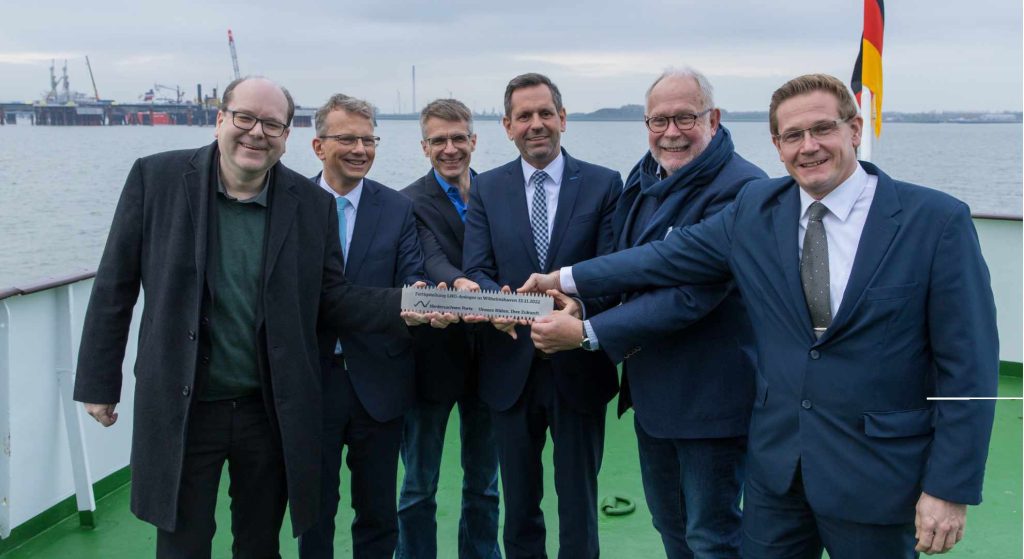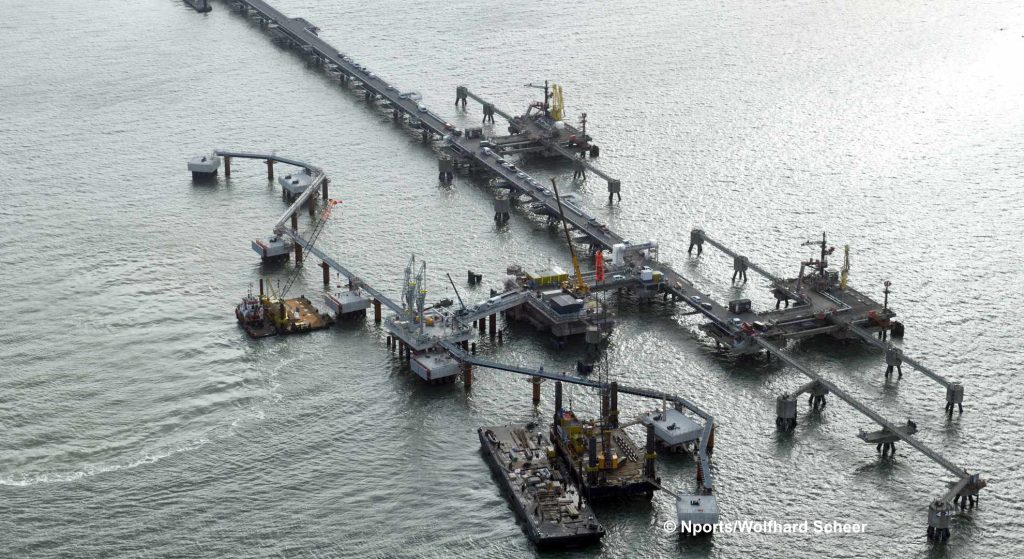The port infrastructure for Germany's first LNG jetty is in place
Wilhelmshaven | 15.11.2022 After only 194 days, an LNG jetty has been built at Voslapper Groden in Wilhelmshaven. A berthing platform and fender and mooring dolphins for the berth have been built at the existing handling facility. In just one month, the first FSRU, a floating storage and regasification unit, will be able to berth here in mid-December. The Wilhelmshaven site is thus helping to secure the energy supply for Germany. Economics Minister Lies: "A big step towards more security of supply - Niedersachsen has delivered". Olaf Lies, Niedersachsens Minister of Economics, Transport, Building and Digitalisation explains: "Germany is looking to Wilhelmshaven today. The new LNG jetty is a major step towards a secure energy supply. Niedersachsen has delivered within a very short time, and at the much-vaunted new German speed. The early decision to choose Wilhelmshaven as a hub for LNG imports was the right one. The already existing port infrastructure as well as the excellent framework conditions have contributed to the project becoming a success story. This was made possible above all by the precise coordination and highly professional cooperation of all project partners. Innovation and engineering skills were the driving forces behind an infrastructure project of national importance. My thanks go to all the planners, surveyors, construction companies, the NLWKN and especially the NPorts team involved." Environment and Energy Minister Meyer: "Replace fossil gases with climate-neutral gases as quickly as possible". "The new NPorts feeder will ensure a contribution to security of supply in Lower Saxony and Germany. At the same time, we want to use the energy turnaround turbo and the expansion of renewable energies and storage to reduce imports of fossil energies ever further as quickly as possible in line with our climate targets. The goal is to switch to climate-neutral green gases as quickly as possible and to make Wilhelmshaven the hub for green hydrogen and the import of renewable energies from the North Sea," says Environment and Energy Minister Christian Meyer. Thanks to strong partners The port company Niedersachsen Ports GmbH & Co. KG as the client, with the support of JadeWeserPort Realisierungs GmbH, Depenbrock Ingenieurwasserbau GmbH & Co. KG and Kurt Fredrich Spezialtiefbau GmbH worked together on the rapid implementation. Holger Banik, Managing Director of Niedersachsen Ports and JadeWeserPort Realisierungs GmbH & Co. KG expresses his thanks to the teams on site: "All those involved have worked tirelessly day after day under high time pressure to ensure that this jetty is completed on time. They have worked hard to make our contribution to a secure energy supply. This achievement deserves our very special recognition." In the sense of passing the baton, Niedersachsen Ports handed over the port infrastructure to the company Uniper. At the same time, Uniper has begun to build a connection between the FSRU and the onshore facilities (superstructure) on the harbour jetty. "Our common goal is in sight. In just one month we will be able to welcome the first LNG terminal ship here," Banik adds. The further connection to the natural gas pipeline network 28 kilometres away and thus also to the Etzel natural gas storage facility is currently being realised by Open Grid Europe GmbH (OGE). In this context, Banik points to the importance of seaports for the energy transition: "It is our North Sea coast that plays a decisive role in the energy transition. It is our strategy to develop our ports as hubs for sustainable energy production." Background: The project of Germany's first LNG berth is under high time pressure and is of great importance for guaranteeing Germany's energy supply. Due to Russia's war against Ukraine, Germany's gas supply is no longer secure. Literally from one day to the next, alternatives had to be created to secure the gas supply over the winter. Wilhelmshaven proved to be the ideal location for a liquefied natural gas terminal, as a corresponding jetty already existed with Vynova's UVG bridge. The existing bridge has been repaired piece by piece in recent years and is now operational and efficient. Niedersachsen Ports had previously examined the feasibility of an LNG terminal together with Uniper. The first FSRU will be able to berth here in just one month. Niedersachsens Agency for Water Management, Coastal Protection and Nature Conservation (NLWKN) has approved the early start of construction on 1 May 2022. On 5 May, construction began with the first pile driving. Construction work: A total of 30 to 40 people were employed on the construction site over the entire construction period, depending on requirements. For the foundation, 194 piles were driven into the ground to give the structure the necessary stability. Nine semi-precast concrete parts were prefabricated and transported to the construction site by pontoon. The individual parts weigh between 160 and 380 tonnes. The platform and the access walkways of the jetty were made from these concrete parts. Steel was also used for the access walkways - a total length of 350 metres for 18 walkways. Finally, to secure the FSRU, slipping hooks were attached to the mooring beams, which are designed for a weight of 150 tonnes. In total, over 7,000 tonnes of steel and over 3,000 square metres of concrete were used. |
Copyright: Nports / Andreas Burmann



